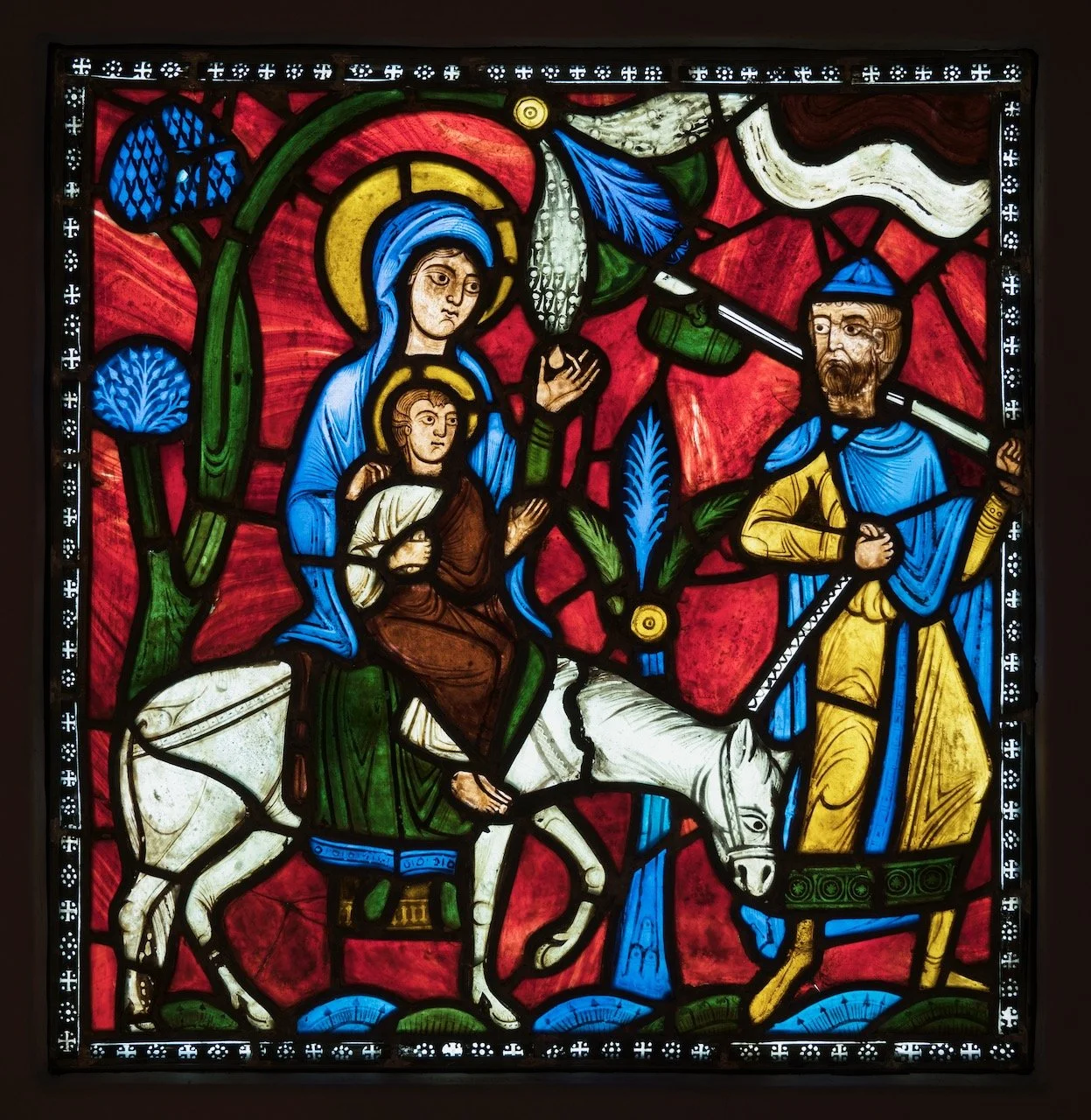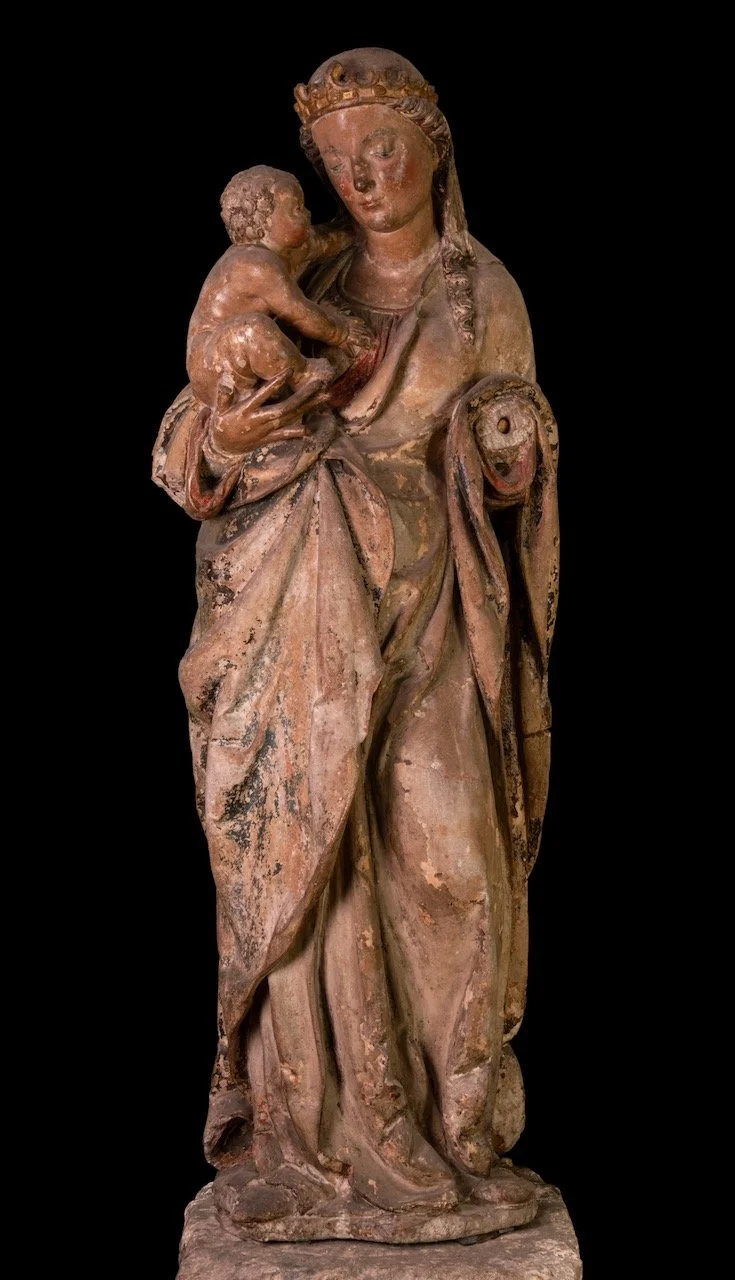Medieval European Collection
The Flight into Egypt from the Abbey Church at Saint-Denis, France (c. 1140–1145 CE).
Raymond Pitcairn originally began collecting medieval art to serve as inspiration for the artists and craftsmen working on Bryn Athyn Cathedral. He later designed Glencairn—his Romanesque-style home in Bryn Athyn—as a setting for his growing collection. In the words of Philippe de Montebello, director of the Metropolitan Museum of Art from 1977 to 2008, “The Romanesque and Gothic art assembled by Raymond Pitcairn in the early part of this century represents the world’s finest and most extensive collection of medieval sculpture and stained glass still in private hands” (Radiance and Reflection: Medieval Art from the Raymond Pitcairn Collection, 1982, 4). The Museum has dedicated two galleries to medieval art. In addition, many works of medieval stained glass and sculpture are installed in the magnificent Great Hall, a central feature envisioned by Pitcairn.
Pitcairn believed that medieval art should be integrated into architecture—not isolated from it. In a 1922 letter to his brother Theodore, eight years before ground was broken for Glencairn, Raymond reflected:
“One of the most striking differences between art of the past and that of today is the fact that the ancient art objects were not isolated things which were more or less forced into their surroundings, they were part and parcel of the temple, the acropolis, the house or tomb for which they were made. Our private collections as well as our museums are full of things which do not really fit their surroundings and with the introduction of oil painting on canvass, art became more and more divorced from its proper relation to the living conditions of the people. . . I should like, one day, to incorporate my little collection into a studio which would be a Romanesque or early Gothic room or small building, but after all the more important work is the production of something new. The collector’s work is interesting but it is far easier than productive work.”
One of the Museum’s most significant panels of stained glass depicts the Flight into Egypt (c. 1140-1145). In this story from the Gospel of Matthew (2:13–15), Joseph is warned to flee the wrath of King Herod with Mary and the infant Jesus. The Pitcairn Flight is the best-preserved surviving panel from one of the principal stained-glass windows created for the first Gothic building: Abbot Suger’s reconstruction of the choir of the Abbey Church of Saint-Denis.
Mary holding the Christ Child, France (15th century CE).
Read about the medieval collection in Glencairn Museum News:
Think Pink! Some Marble Sculptures in the Glencairn Collection and Their Southern French Origins
Christ Receiving His Mother’s Soul: A Thirteenth-Century Stained-Glass Panel
Museums of Medieval Art at the Time of Glencairn’s Creation: Between Authenticity and Fiction
The Simurgh is Calling: A Journey into Love through Arts, Empathy, and the Oneness Mindset
Medieval Treasures from the Glencairn Museum: A Loan Exhibition at the Philadelphia Museum of Art
Why Did Raymond Pitcairn Build Glencairn? From Cloister Studio to Castle
A Thousand-Year Journey: An Ivory Box on Loan to the Met Cloisters
Interview with Dr. Charles T. Little: Reflections on the Early Days of Glencairn Museum
Glencairn’s Guest of Honor: The 1965 Visit of a “Monuments Man”
Seven Sleepers and Seven Kneelers: Three Thirteenth-Century Stained-Glass Panels from Rouen
A Medievalist in the Archives: Exploring Twentieth-Century Medievalism at Glencairn
The Annunciation and Second Coming Frescoes in Glencairn’s Great Hall
Glencairn’s Royalty: Images of Kings and Queens in the Medieval Collection
Medieval Depictions of the Last Judgment: The Resurrection of the Body
Reflected Glories: Raymond Pitcairn’s Loans to the Philadelphia Museum of Art
Protective Images from Glencairn’s Medieval Sculpture Collection
Hidden in Plain Sight: A Capital from Saint-Guilhem-le-Désert
Capital from the Abbey Church of Moutiers-Saint-Jean , C. 1150–60
Recommended reading:
Hayward, Jane, and Walter Cahn. Radiance and Reflection: Medieval Art from the Raymond Pitcairn Collection. Exhibition catalog for the Cloisters, Metropolitan Museum of Art, New York, February 25–September 15, 1982. New York: Metropolitan Museum of Art, 1982.


